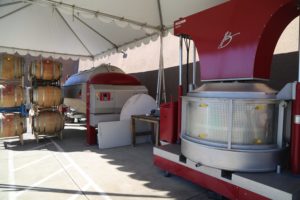
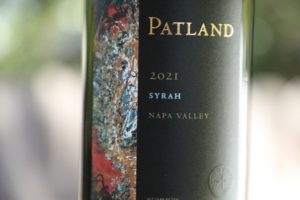
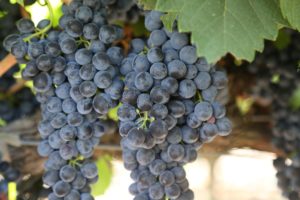 Patland Estate Vineyards was founded by Henry and Olga Patland with the purchase of their property on Soda Canyon (southern Napa Valley) in 2007. Henry immigrated to Miami from Ukraine in 1978 when he was still a child; the family made ends meet by delivering newspapers. Later he and his family moved to San Francisco where his parents opened a video store near Golden Gate Park selling copies of Russian Films and TV shows to the local Russian community. This entrepreneurial spirit was instilled in Henry; today he runs a successful high tech data storage company based in the Silicon Valley.
Patland Estate Vineyards was founded by Henry and Olga Patland with the purchase of their property on Soda Canyon (southern Napa Valley) in 2007. Henry immigrated to Miami from Ukraine in 1978 when he was still a child; the family made ends meet by delivering newspapers. Later he and his family moved to San Francisco where his parents opened a video store near Golden Gate Park selling copies of Russian Films and TV shows to the local Russian community. This entrepreneurial spirit was instilled in Henry; today he runs a successful high tech data storage company based in the Silicon Valley.
Henry met his wife Olga (also from Ukraine) while in college at UC Santa Cruz. He and Olga have enjoyed fine wines for many years and would often visit Napa Valley based on its proximity to San Jose. The first time they envisioned owning a winery was while visiting Peju Winery in the 1980s; Tony Peju was pouring wine behind the bar to guests. The Patlands were inspired by Peju – hearing his stories about owning a winery and the passion in his voice when he talked about wine.
In 2007 Henry decided to try and sell Integral Solutions Int’l (a provider of disk drive/magnetic testing services), a company he co-founded in 1995. He and Olga planned on retiring to Napa Valley where they wanted to purchase a vineyard. Their real estate agent connected them to a property high on the slopes of the Atlas Peak sub appellation above Soda Canyon. Henry recalls they visited on a miserable and rainy day; as a result they weren’t immediatley impressed with the property. The owner was Jack Daniels of Wilson Daniels, the fine wine company based in Napa, representing some of the world’s most prestigious wineries. Daniels wisely told them to come back the next day. Fortunately the storm had cleared and they were able to walk the property in bright sunshine. The mood was completely different than the day before; Olga was immediately sold on the views and the property.
Part of the Patland estate offers stunning overlooks onto Soda Canyon below as well as the southern part of Napa Valley including the San Pablo Bay. The fog line is typically below their property and at times it can be a sea of white further down while the sun shines brightly on their vineyards.
Henry attempted to sell his company then but had no success, complicated by the economic downturn in 2008. Ultimately it was never sold and he remains the company President and CEO. The first Patland Estate proprietary wine was from the 2007 vintage made from the original Italian varieties that were growing on the property at the time of their purchase. Daniels had a strong interest in Italian wines so had planted these grapes during his ownership of the property.
Their property is named Terra del Cuore, which in Italian translates to “land of the heart”; the name makes sense considering the beautiful estate and Tuscan styled home. The property is located at about 1,600 feet in elevation and is 36 acres of which only approximately 4 acres are planted to vine. The home was destroyed in the Atlas Peak fire of 2017 but has since been rebuilt. And following these fires, the Patland family purchased property along the southern part of the Silverado Trail; it includes 6 acres of vines planted to Cabernet Sauvignon and a bit of Malbec.
They decided to replant the Italian varieties to Malbec. The reason for this was two-fold; the Patland’s visited Mendoza in Argentina where they were exposed Malbec and unrelated to their trip, their winemaker at the time Jay Buoncristiani made a recommendation to plant Malbec. They followed his advice and as expected it has thrived in these low nutrient and extremely rocky soils. Malbec is now used for a 100% varietal limited release bottling from the estate; as of our latest update to this review, this is their only Atlas Peak estate wine, although small amounts of estate Malbec are also blended into some of their other red wines.
They make a variety of both red and white wines and source the grapes for these wines from several vineyards in Napa Valley including Stagecoach Vineyard located much further up Soda Canyon Road. This vineyard is one of Napa Valley’s largest mountain vineyards (sold in 2017 to GALLO). The previous owner Dr. Jan Krupp told us he had to make 40 phone calls to various vintners initially when trying to sell the first vintage of his grapes. How that has changed; grapes from this vineyard are now sold to a number a premium wineries in the valley.
During a visit to Jerusalem (Olga immigrated from Israel) they purchased a silver coin from an antique coin shop which dated from 67 C.E. with the image of a pomegranate on one side. Their property was already planted to a number of pomegranates; this fruit reminded Henry of parts of Ukraine where many pomegranates are cultivated. Olga decided it would make a nice symbol in their wine packaging. Today the image of this coin is embossed on the front label of all their wines.
Their initial production was just several hundred cases. Today they produce a wide variety of wines from whites to reds with a total annual production of around 3,000 cases. Henry has grown the label wisely over the years. From his prior business experience, he has learned to keep supplies ahead of demand and over the past few years they have steadily increased both production based on demand and built a thriving wine club. All their bottles are numbered on the back label.
Ever since a child, the Patland’s eldest son Michael’s first love has been art. It wasn’t until much later in life when he began to look at wine as art that he began to develop an appreciation for the wine industry. Art like wine is a subjective experience; wanting to blend the two crafts, he contacted an artist who was a mentor to him as a child. He arranged a private showing with Croatian artist Dzemal Emric (lives near San Jose); Michael chose several unique labels for each of the Patland wines. The works chosen are abstracts highlighting the subjective nature in both art and wine.
Michael was also founder of The Hidden Gallery; a Napa Valley based brand that focused on wines not generally associated with contemporary Napa Valley bottlings. And Michael’s brother Felix is Patland’s head winemaker having taken over from their previous winemaker Buonchristiani.
Select Wines
Whites
Sauvignon Blanc

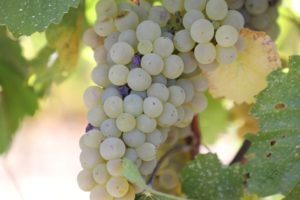 The 2023 Patland Estate Sauvignon Blanc, Napa Valley is pale straw in color; comfortably saddled between California ripeness and the more herbal characteristics representative of this variety, the bouquet smells like lemon blossom, golden kiwi, passion fruit, guava, young kaffir lime leaf, not fully ripe pineapple, white peach, white nectarine and light touch of herbs including thyme and lemongrass. And a finishing but underlying layer of vanilla. Superbly balanced this wine chirps a beautiful song in terms of its interaction between flavor, acidity and texture. On the palate, there are flavors of passion fruit, honeydew melon, tropical guava, jasmine, white peach, white nectarine, apricot and plenty of citrus influences including of pomelo, Meyer lemon and kumquat. Finishes flavorful, juicy and refreshing with a silky and supple texture sporting a comfortable weight. The mouth feel is lifted high by its vibrant but not bracing acidity. This wine is made with grapes from the Alsace Vineyard and Navone Vineyard, both in Rutherford (incidentally one of our favorite sub AVA’s in Napa Valley for growing this variety). This wine was aged for 6 months in 8% stainless steel vessels, 14% new French oak, 58% concrete egg and 20% in neutral oak. And its pH is a tidy 3.28. Versatile in terms of outdoor temperatures; for example enjoy a glass of this beauty next to pool on a hot summer day, or cradle a glass, warming up the wine on a chilly winter day with a plate of lightly seared oysters and a view of the rugged northern California coastline.
The 2023 Patland Estate Sauvignon Blanc, Napa Valley is pale straw in color; comfortably saddled between California ripeness and the more herbal characteristics representative of this variety, the bouquet smells like lemon blossom, golden kiwi, passion fruit, guava, young kaffir lime leaf, not fully ripe pineapple, white peach, white nectarine and light touch of herbs including thyme and lemongrass. And a finishing but underlying layer of vanilla. Superbly balanced this wine chirps a beautiful song in terms of its interaction between flavor, acidity and texture. On the palate, there are flavors of passion fruit, honeydew melon, tropical guava, jasmine, white peach, white nectarine, apricot and plenty of citrus influences including of pomelo, Meyer lemon and kumquat. Finishes flavorful, juicy and refreshing with a silky and supple texture sporting a comfortable weight. The mouth feel is lifted high by its vibrant but not bracing acidity. This wine is made with grapes from the Alsace Vineyard and Navone Vineyard, both in Rutherford (incidentally one of our favorite sub AVA’s in Napa Valley for growing this variety). This wine was aged for 6 months in 8% stainless steel vessels, 14% new French oak, 58% concrete egg and 20% in neutral oak. And its pH is a tidy 3.28. Versatile in terms of outdoor temperatures; for example enjoy a glass of this beauty next to pool on a hot summer day, or cradle a glass, warming up the wine on a chilly winter day with a plate of lightly seared oysters and a view of the rugged northern California coastline.
The 2013 Patland Estate Sauvignon Blanc is from Tench Vineyard, located on the east side of Oakville bordering the Silverado Trail and Screaming Eagle. The 2013 Patland Estate Sauvignon Blanc reveals pleasing aromatics which are more tropical than grassy and showcases rich fruit including yellow pineapple along with assorted white florals. Think springtime. The palate features a diversity of tropical flavors, supported by a balanced but bright acidity. The finish lingers with delicate flavors of red and green apple. Their Sauvignon Blanc is always thoughtfully made; during its aging the wine is exposed to a variety of vessels including concrete eggs, stainless steel drums and both new and used French oak barrels. And we aren’t familiar with much Sauvignon Blanc from Oakville, rather this variety is more commonly grown in Yountville and to some extent in Rutherford, where it particularly excels.
Chardonnay
The 2023 Patland Estate Chardonnay is medium gold in color; ten years between our last tasted vintage of this wine, the nose is remarkably similar to the 2013 bottling. This wine smells fully ripe and is a rich expression of both the variety and California sunshine. Its scents include butterscotch, honeysuckle, caramel, glazed pineapple, baked apples, apricot jam, yellow peaches in light syrup, vanilla and honeycomb. Pulling as much from the grape on the palate as on the bouquet, this wine tastes like glazed pineapple, yellow peaches in syrup, apricot, fully ripe yellow nectarines, butterscotch, honeycomb, Alphonse mango and a finishing note of vanilla. Rich, layered and intensely flavored, the mouth feel offers a creamy and supple texture. The acidity needs to hold up to these other noteworthy characteristics, and it does, with its tangy and vibrant attributes. The grapes for this bottling are from two noteworthy vineyards in Napa Valley, Stagecoach on Atlas Peak and Hyde Vineyard in Carneros. This wine was aged for 10 months in 35% once fill French oak barrels and 65% in twice and third time fill French oak barrels. This is a warm fire, deep couch, significant other next to you, Lake Tahoe, mountain cabin, wintertime, middle of snowstorm kind of wine.
The 2013 Patland Estate Chardonnay is medium gold in color; the nose shows toasted caramel, assorted sweet baking spices, baked pear, banana and minerally or graphite character. The entry is soft and rounded and surprisingly focuses on the fruit rather than the oak based on its fermentation and aging program. The wine was barrel fermented and then saw extended aging all in French oak barrels. On the palate there are flavors of red apple and notes of vanilla, especially noticeable on the finish. Lingers flavorful and bright, immediately begging for a another sip. Regardless of vintage, the Patland Estate Chardonnay is always a ripe and full expression of this variety. And it can stand up against some of the other powerhouse Chardonnays being produced in Napa Valley, but for far less of a price.
Rosé
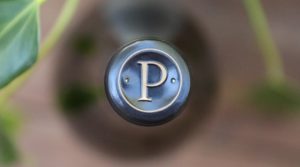
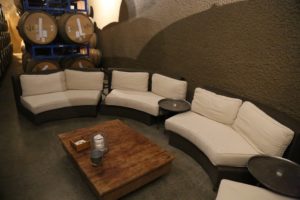
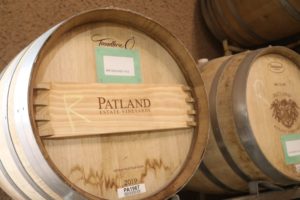 The 2013 Patland Estate Rosé of Syrah features a generously layered bouquet yet is simultaneously elegant and floral. From the aromas, one might guess this wine will not be lightweight on the palate. And that is accurate. It features a noticeable but pleasing weight while showcasing bright acidity. One of the flavors we taste is that of watermelon, which reminded us of licking jolly rancher candy. An additional flavor is of raspberry. The lingering finish persists for quite some time with a hint of spice including subtle notes of white pepper. The wine is crisp and clean across the palate and is refreshing to enjoy cool – on a warm summer day. Highly worth seeking out.
The 2013 Patland Estate Rosé of Syrah features a generously layered bouquet yet is simultaneously elegant and floral. From the aromas, one might guess this wine will not be lightweight on the palate. And that is accurate. It features a noticeable but pleasing weight while showcasing bright acidity. One of the flavors we taste is that of watermelon, which reminded us of licking jolly rancher candy. An additional flavor is of raspberry. The lingering finish persists for quite some time with a hint of spice including subtle notes of white pepper. The wine is crisp and clean across the palate and is refreshing to enjoy cool – on a warm summer day. Highly worth seeking out.
Reds
Due to smoke issues resulting from the Glass Fire in 2020, Patland Estate did not produce any red wines from Napa Valley that year. Instead they looked to California’s Central Coast and settled on several vineyards in Paso Robles.
Proprietary
The 2020 Patland Proprietary Red Wine, Paso Robles is deep ruby in color and nearly opaque; its ripe and fruit driven aromatics immediately jump out of the glass; there is no shyness here. Its scents include dark cherry, raspberry at the peak of its ripeness, boysenberry, blueberry and Satsuma plum. As the wine evolves it opens to secondary scents which displace the core fruit to some extent, including toasted cedar, dark chocolate, espresso and mocha. The plush and juicy palate offers an intensity of flavor including of dark plum, blackberry, boysenberry, cherry and mulberry. If we had to identify its varietal composition, we would guess there is a healthy amount of both Cabernet Sauvignon and Syrah in this bottling. The finish lingers savory, dark and spicy showing notes of crushed peppercorn, dried sage, tobacco, toasted cedar and dark cocoa powder. The lightly grainy and gravelly tannins have a tumbled texture and are fairly well integrated into the finish four years post vintage.
Syrah
The 2021 Patland Estate Syrah is deep purple and completely opaque. This wine is not lacking in terms of its color. Sweetly fruited with loads of aromatic depth, on the bouquet there are sweetly fruited scents of blackberry pie, dark cherry at the peak of ripeness without crossing into the over ripe territory, boysenberry jam, and Satsuma plum. And non fruited and supporting notes include dark chocolate, lilac, lavender, cloves and a sweet tobacco spice. Mouth filling lusciousness, but with its ripe flavors firmly rooted by its vibrant acidity and an accompanying pH of 3.54. Juicy, this wine tastes like dark plum, blackberry, boysenberry and Persian mulberry. It finishes a note of dried herbs, a pinch of crushed peppercorn and with grainy and gravelly dusty textured tannins which are particular pronounced on the front and sides of the palate. Not disconnected from the rest of the palate profile, their grippy texture lingers in tandem with the fruit, with neither fruit nor tannins soon pulling away from each other. Think BBQ and steak. The grapes for this wine are from Stagecoach Vineyards & Viking Vineyards; the wine was aged in 35% new French oak barrels. This wine pairs particular well with the song Don’t Think I Could Forgive You by Torrie Banks turned up full volume or for something a bit more restrained, Play Me by Neil Diamond.
Cabernet Sauvignon
The 2018 Patland Estate Cabernet Sauvignon, Napa Valley is deep ruby and opaque. We tasted this wine 7 years post vintage. Offers a brief burst of bottle funk; give it time to open and the fruit will become more expressive. Brightly lit and red fruited, its aromatics include red cherry, currant, cranberry, not fully ripe boysenberry, and a light ferrous character. Filled with energy at this age, this wine still has plenty of ‘coil’ left in its spring due to its vivacious and vibrant acidity. Red fruited and tart, this wine tastes like cherry, currant, cranberry and raspberry. Mouth watering. Refreshing. Juicy. Crunch. Its tannins are gravelly and grainy, persisting with a pixelated grip that outruns the fruit on the finish. This wine is still a teenager and very much primary at this age. In a blind tasting, we probably would have noted this bottling as a 2021 or perhaps even a 2023 vintage.
A wine similar in style to the ones that Henry enjoys drinking and a big part of the reason he used to visit Napa Valley, is now part of their portfolio. This wine is their Reserve Cabernet Sauvignon. While tasting various wines in various proportions during blending trials for the 2010 vintage with Jay, they were struggling to find the best blend to bottle commercially. But then Henry tasted the 100% varietal Cabernet Sauvignon. Immediately he knew this was the wine he wanted to bottle. Every year it is a barrel selection; in 2010 all the grapes were sourced from Stagecoach Vineyard.
The 2010 Patland Estate Reserve Cabernet Sauvignon is deep ruby; it shows slightly smoky and slightly herbal in the glass but with plenty of layered and complex dark fruited aromas. The entry on the palate is soft but quickly gains in strength until the wine presents chalky and earthy tannins that coat the palate from front to back. They are long-lasting. The tannins soften noticeably as this wine breathes – and decanting is recommended. Its flavors include blackberry, black cherry and dark chocolate. This is a big robust mountain Napa Valley Cabernet Sauvignon.
—
The Caves at Soda Canyon
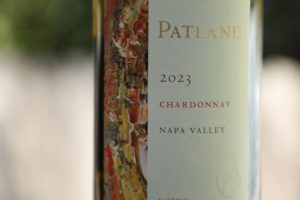
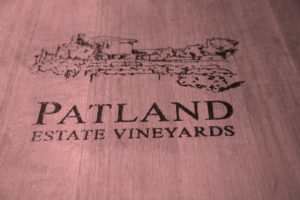 The Patlands are part of the original 4-family winery partnership called the Caves at Soda Canyon located a few miles down the road from their estate vineyard. This is a premium underground winery that offers both production and hospitality space for a limited number of small producers. The property is located in Atlas Peak; while only around a 20-minute drive from downtown Napa, the feel here is definitely hillside remote. We first visited many years ago when it was just under the initial stages of construction. Our early visit was with visionary for The Caves at Soda Canyon, vintner Ryan Waugh who was accompanied by winemaker Craig MaClean.
The Patlands are part of the original 4-family winery partnership called the Caves at Soda Canyon located a few miles down the road from their estate vineyard. This is a premium underground winery that offers both production and hospitality space for a limited number of small producers. The property is located in Atlas Peak; while only around a 20-minute drive from downtown Napa, the feel here is definitely hillside remote. We first visited many years ago when it was just under the initial stages of construction. Our early visit was with visionary for The Caves at Soda Canyon, vintner Ryan Waugh who was accompanied by winemaker Craig MaClean.
It opened in late 2013 and initially its focus was a production space with limited hospitality available for wines produced by the original four founding winery members: Waugh, Lobo, Patland and Buoncristiani Family Winery. In 2020 a wing of the cave finally opened for hospitality; over the years the cave is now used for both production and hospitality by additional small family-owned brands. One can make an appointment directly with these brands to taste only their wines, including Patland Estate, or one can make an appointment directly with The Caves at Soda Canyon, where a tasting will highlight select wines from some of the producers.
In the face of natural disasters, this winery has two strong advantages, and it has already been tested twice since opening. Advantage number one is its underground location and advantage number two is it is built into what essentially looks like a giant rock pile. The winery survived the Napa earthquake of 2014 without loss of product (despite significant damage to the relatively nearby city of Napa) and during the Atlas Peak fire of October 2017, again the interior was safe as the fire did not enter the cave, yet it burned all the landscape around the winery and even partially melted some of their outside tanks and the asphalt of their parking lot.
This winery offers a luxurious and well lighted interior alcove for tastings (one of our pet peeves is always caves with bad lighting – one will not find that here), as well as a beautiful space on an outdoor terrace overlooking much of the central to southern part of the valley including the San Francisco skyline seen in the distance on an exceptionally clear day. An upper outdoor space can also be used for tastings and offers expansive vistas of the southern part of Napa Valley.
Visits here are by appointment, are highly personalized and are a unique opportunity taste the Patland Estate wines. Both a tour and a tasting are offered and weather permitting, a visit to the exterior of one of the cave portals with expansive views overlooking the southern part of Napa Valley. For more information, to reserve a visit, to join their Perpetuum Allocation list or to purchase both current vintages and a selection of library wines dating all the way back to their first vintage, visit: www.patlandvineyards.com

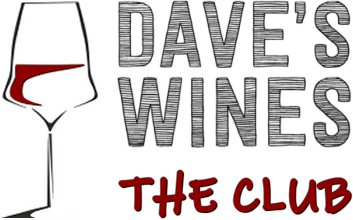




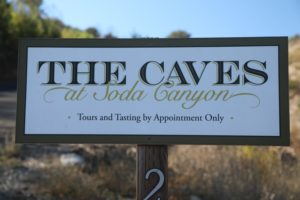


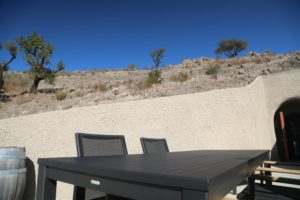
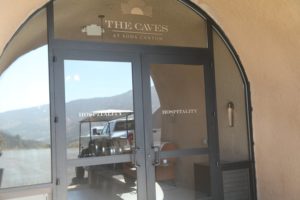
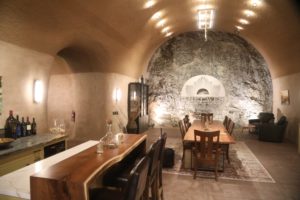
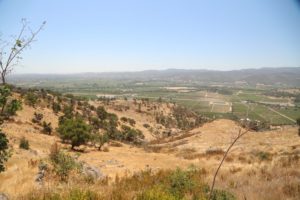
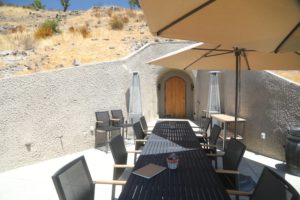
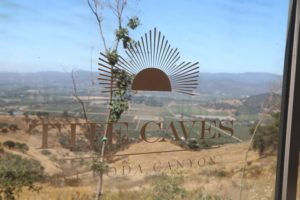
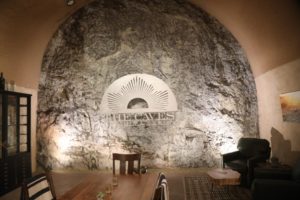
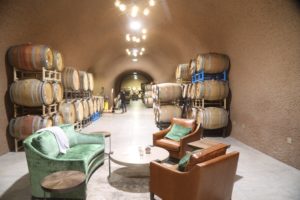
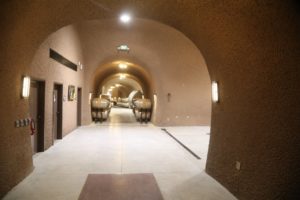
We are all hoping for a speedy recovering from the Atlas Peak Fire – this has been devastating to a number of homes and wineries including Patland Estate.